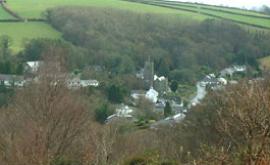


Small but pretty village in a wooded valley
Web: www.stneot.org.uk
St. Neot is a small village in a deep wooded hollow, just south of Colliford Lake, Bodmin Moor's largest reservoir and two miles north of the A38 which runs through the Glynn Valley from Liskeard to Bodmin. The village originally grew up on wool, tin and slate, but that has all gone now. The population of the village was 1.000 at the 2011 census.
The church of St. Neot, standing proud in the small village which nestles below the heights of Bodmin Moor, is famed throughout the country for its stained glass. At least half of the glass in the fifteen windows dates from the 15th and 16th centuries and depicts saints and angels, the flood, and the story of Saint Neot (said to have been only four feet tall). Amongst the fine crosses in the church yard is the shaft of one from the 9th century which is said to be the finest ornamented cross in Cornwall.
The St. Neot well is also dedicated to the Saint. Standing at the foot of a rocky outcrop covered in trees the waters of this well, restored in 1852, are said to cure sick children, particularly in May around the time of Beltane.
During the Civil War, the village supported the King cause and this is still commemorated each year by placing an oak branch on the church tower on Oak Apple Day (May 29th). The story being, of course, that King Charles escaped from his pursuers by hiding in an oak tree.
No railway was ever built to the village, despite pressure from local people and mine owners in the 1860's and 1870's. Instead, Doublebois railway station was opened on 1st June 1860 about two miles south of St. Neot on the Cornwall Railway main line, it closed again on 5th October 1964.
The old coach road between Liskeard and Bodmin once ran through this village and in the slate caves to the south the navy stored their rum rations for safe keeping during wartime. These caves (Carnglaze Slate Caverns) are now open to the public and form an unusual music venue.
About one mile to the north east is a hillfort known as Berry Down Castle. The hillfort is traditionally dated to the Iron Age (300 BC) but may date back to the Bronze Age (1500 BC). Clearly visible within the banks are the remains of nine hut circles with a tenth circle near the top of the hill outside the bank.
In 2004 and 2006, the village of St. Neot won the National Calor Village of the Year award. St. Neot also won the Calor Gas Village of the Decade award, which celebrated 10 years of the competition.
Oak Apple Day - 29th May.
St. Neot Feast Day - end of July.
John Anstis (1669-1744) who became Garter King at Arms was born in the village.
Henry Dangar (1796–1861) was a native of St. Neot who became a surveyor and explorer of Australia.
Bodmin Bodmin Moor Bolventor Cardinham Liskeard St. Cleer The Copper Trail
Carnglaze Slate Caverns Colliford Lake Dobwalls Family Adventure Park St. Neot Pottery The Caradon Trail